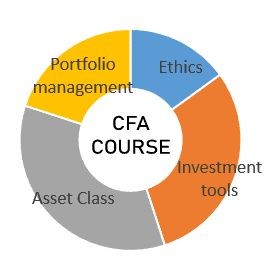
If you are in a situation finding difficulty to choose between CFA and FRM or wondering how to do both simultaneously, then we’ll help you decide.
A CFA and FRM combination can be an excellent choice as the competitive finance world demands you to have varied skill sets. As both the designations are powerhouse of finance. However, the challenge of clearing the CFA and FRM exams together remains. Before pursuing this combination, you must have a fair idea about the exams and strategies accordingly.
Things To Consider Before Opting For CFA and FRM
There are certain things you must have a clear idea about when you decide to opt for the CFA and FRM combination.
CFA and FRM: Exam Structure
Conducted by the CFA Institute (USA), you must pass three levels of exams to complete the CFA course. The CFA pass percentage for each level (August 2022) is as follows:
- Level I (37%)
- Level II (40%)
- Level III (48%)
On the contrary, you will need to clear two levels of the FRM exam conducted by GARP (the Global Association of Risk Performance). The latest FRM pass rates for the two parts are:
- Part I (51%)
- Part II (57%)
You can take Part I (morning session) and Part II (afternoon session) of the FRM on the same day.
CFA and FRM: Syllabus
To complete the syllabus for CFA, you must devote at least 300 hours to each level. The syllabus for CFA is centred around the following topics:
- Economics
- Quantitative Methods
- Financial Reporting and Analysis
- Ethics
- Fixed Income and Derivatives
- Corporate Finance
- Equities and Alternative Investment
- Portfolio Management
The FRM syllabus also demands 200-250 hours for each part. The topics in this course include the following:
- Financial Markets and Products
- Foundations of Risk Management
- Credit Risk
- Quantitative Analysis
- Market Risk
- Investment Management
- Operational Risk
- Valuation and Risk Models
- Liquidity and Treasury Risk
CFA and FRM: Fees structure
You must be aware of the fee structure when opting for the CFA and FRM combination to avoid any financial burden.
| Cost | CFA | FRM |
| Enrollment fee | $450 (Rs. 36,581) | $400 (Rs. 32,517) |
| Registration fee (per level) | $700-$1000 (Rs. 56,904- Rs. 81,292) | $550-750 (Rs. 44,710- Rs. 60,969) |
CFA and FRM: Career Opportunities
CFA certification equips you with real-world skills and expertise in the field of investment analysis. Job roles you can land after earning a CFA certification include:
- Portfolio Manager
- Financial Consultant
- Strategic Analyst
- Wealth Manager
- Investment Analyst
Identifying, analyzing, and mitigating risk are skills you will acquire after the FRM course. The job roles in this field include:
- Investment Banker
- Risk Analyst
- Financial Risk Consultant
- Risk Manager
CFA and FRM salary packages are quite lucrative, and pursuing the CFA and FRM combination can open up a pool of job opportunities for you.
Syllabus overlapping
A significant part of the FRM exam is covered by the CFA syllabus, with most of the overlap between these designations found in the FRM Part 1 exam.
We estimate that about 55% of FRM Part 1 is covered by the CFA program (all 3 levels), whereas that figure drops to about 15% for FRM Part 2.
This is an interesting insight for those who are keen on obtaining both CFA and FRM certifications (in the shortest possible time) for their career.
The FRM curriculum covers a variety of risk management topics and provides guidance on how to view these concepts in an integrated fashion.
The FRM exam is tested in two parts:
- the Part 1 exam focuses on the fundamental tools and techniques used to assess risk; whereas
- the Part 2 exam focuses on the application of those tools in practice and further examines the major subcategories of risk management (e.g. market, credit, and operational risk).

On the other hand, CFA exam is tested in 3 levels:
- Level 1 exam doesn’t assume any prior finance knowledge, and focuses on introducing various terms and concepts of the 10 topics.
- Level 2 exam builds on the foundation of Level 1, with a stronger focus on analyzing and applying the concepts learned.
- Level 3 exam is heavily focused on applying what you’ve learned holistically in portfolio management and wealth planning topics.
How to proceed?
Now, you must be thinking: How do I approach CFA and FRM together? What should my preparation look like?
This totally depends on which course you want to prioritize. Whether you clear your exams on the first attempt is also a deciding factor when devising a preparation strategy.
But if you aim to get both certifications within the shortest possible time, then you should approach the CFA and FRM exams in the following order:
- CFA Level I
- CFA Level II
- FRM Part I
- CFA Level III
- FRM Part 2
Taking the exams in this order will help you to get the necessary knowledge you need to pass both the CFA and FRM exams. This order will also help you save time and energy, as many topics overlap between CFA and FRM.
Plus, you will need to adopt a healthy lifestyle to avoid physical and mental burnout.
Motivation tips
Preparing for the CFA and FRM together can wear you out. But the key to success is resilience and hard work.
Here are some simple ways that will keep you motivated during your preparations:
- Take short study breaks when you feel stressed out.
- Having a positive environment around you is the key to staying motivated. Let your friends and family support you throughout the process.
- Avoid multitasking.
- Get adequate sleep.
- Eat healthily and exercise regularly.
Conclusion
Before you start preparing for the CFA and FRM combination, you must ask yourself which course you want to prioritize. While CFA provides knowledge of investments, FRM specializes in risk assessment and management. If your aim is to become a CFA with a specialization in risk management, then opting for the CFA and FRM combination is a wise call.
Thinking of opting for the CFA Level I and Level II before FRM Part I? Check out the CFA course from Zell Education. Curated notes, student mentorship, a personalized study plan, and CFA-qualified faculty will help you get the right guidance for clearing the exams.

